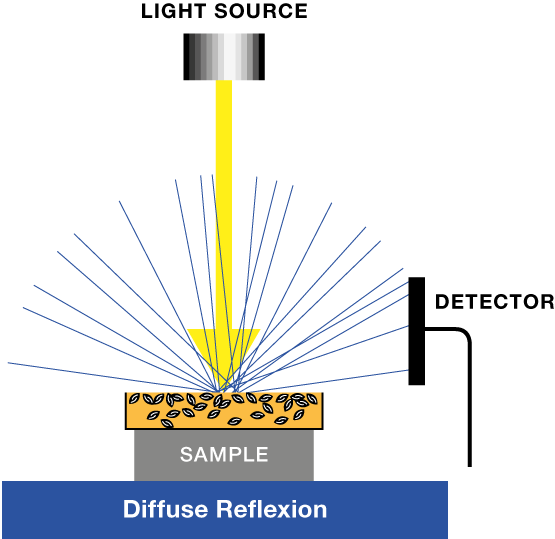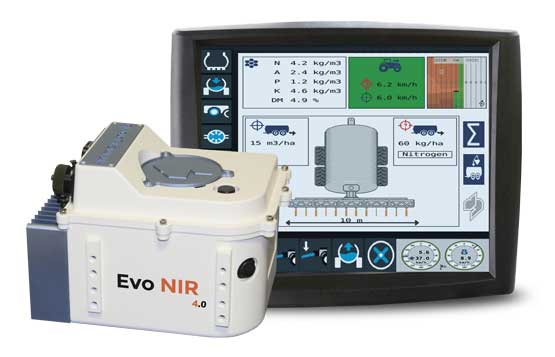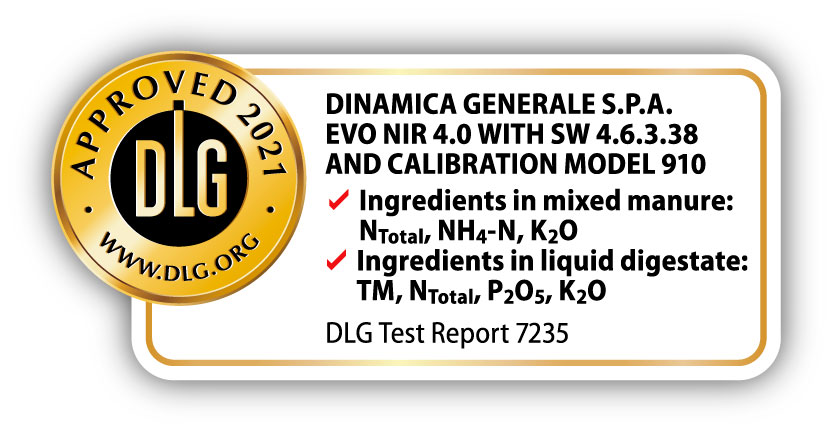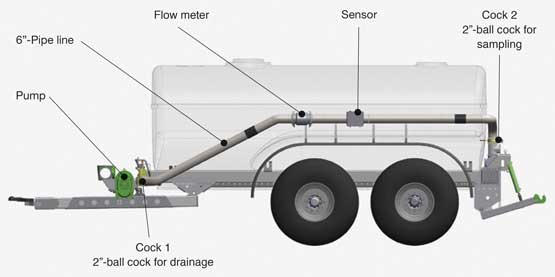DINAMICA GENERALE EVO NIR 4.0 - with SW 4.6.3.38 and calibration model 910
DLG-APPROVED "Ingredients in mixed manure from cattle and pig manure and in liquid digestate"
The quality mark
A test mark “DLG-APPROVED for single, value-determining criteria” is awarded for agricultural products which have successfully fulfilled a reduced usability testing conducted by the DLG according to independent and recognised evaluation criteria. The test is served to highlight particular innovations and key criteria of the test object. The test may contain criteria from the DLG test frame for total tests, or focus on other value-determining characteristics and properties of the subject of the test. The minimum requirements, the test conditions and procedures, as well as the bases of evaluation of the test results are set in agreement with a DLG Experts group. They correspond to the recognized rules of technology as well as the science and agricultural knowledge and requirements. A successful test ends with the publication of a test report and the awarding of the test mark, which is valid for five years from the date of the award. The DLG test for “Precision of NIR sensors for the determination of ingredients in passing liquid
manure of animal origin and liquid digestate from cattle or pig manure with renewable raw materials“ was carried out on the EVO NIR 4.0 with SW 4.6.3.38 and calibration model 910 of DINAMICA GENERALE S.p.A.
The measurements for determining the contents of ingredients were carried out in in liquid mixed manure from cattle and pig manure and in liquid digestate from cattle or pig manure with renewable raw materials. In each manure type, five different practice slurries were examined through the tested sensor for their levels of dry matter content (DM in weight %), total nitrogen (NTotal in kg/m³), ammonium nitrogen (NH4-N in kg/m³), phosphate (phosphorous pentoxide; P2O5 in kg/m3), and potassium oxide (K2O in kg/m³). During the measurements from each slurry samples were collected.
The taken samples were analyzed by a total of five different accredited specialized laboratories, preferably with wet-chemical methods. For each ingredient, the averages from the results of the laboratory analyses were calculated. For the evaluation, the differences between the value measured by the NIR Sensor and the mean value of the laboratories were determined as the relative measurement deviation. The precision of the sensor was examined at different flow rates too.
Other criteria were not tested.
Evaluation – short version
On the basis of the results obtained the mobile sensor EVO NIR 4.0 with SW 4.6.3.38 and calibration model 910 is awarded the DLG test mark „DLG APPROVED in single criteria“ in the measurement of ingredients in liquid manures for the parameters listed in the following table 1.
Table 1: Approved parameters – results at a glance
| DLG quality profile | |
| Ingredient | Evaluation* |
| Mixed manure from cattle and pig manure | |
| Total nitrogen (NTotal) | ✔ |
| Ammonium nitrogen (NH4-N) | ✔ |
| Potassium oxide (K2O) | ✔ |
| Liquid digestate from cattle or pig manure with renewable raw materials | |
| Dry Matter (DM) | ✔ |
| Total nitrogen (NTotal) | ✔ |
| Phosphorous Pentoxide (P2O5) | ✔ |
| Potassium oxide (K2O) | ✔ |
* Evaluation range: requirements fulfilled (✔) / requirements not fulfilled (X)
Product

The EVO NIR 4.0 measuring system is an NIR (NearInfraRed) measuring system developed for the compositional analysis of organic substances. The manufacturer offers applications for balers, combine harvesters, forage harvesters, loading and feed mixer wagons and liquid manure tankers. In the presented DLG test the use on the liquid manure tanker was tested. In the case of the latter, the sensor is integrated into the existing pipe system. To ensure error-free functionality of the sensor, the installation positions specified by the manufacturer must be observed.
Procedure of near infrared measurement
The function of a NIR sensor system is shown in Figure 2.The passing material is separated from sensor through a NIR transparent sapphire window. The passing material is irradiated by a NIR light source with a known spectrum. The reflected or reemitted light is detected. To compensate for the temperature-dependent shifts in the spectrum, the system runs regular white and dark referencing. The measurement data are processed by an evaluation unit and the resulting values are calculated in a microcomputer by using the stored calibration models. The measuring process runs continually while passing of material. In measurement mode, every second measured values are generated. As needed, average values for user-defined time intervals or live values in real time are displayed. The manufacturer specifies the measurement ranges shown in Table 2.
Table 2: Measurement range of EVO NIR 4.0 with SW 4.6.3.38 and calibration model 910
| Parameter | Value range |
| Mixed manure from cattle and pig manure | |
| Total nitrogen (NTotal) | 0,5 - 8,0 kg/m3 |
| Ammonium nitrogen (NH4-N) | 0,0 - 5,0 kg/m3 |
| Potassium oxid (K2O) | 0,5 - 8,0 kg/m3 |
| Liquid digestate from cattle or pig manure with renewable raw materials | |
| Dry Matter (dM) | 0,5 - 15,0 % |
| Total nitrogen (NTotal) | 0,5 - 10,0 kg/m3 |
| Ammonium nitrogen (P2O5) | 0,0 - 4,5 kg/m3 |
| Potassium oxid (K2O) | 0,5 - 8,0 kg/m3 |
The Method
The aim of the DLG Test “Precision of NIR sensors for the determination of ingredients in passing liquid manure of animal origin and liquid digestate“ is to examine the accuracies of mobile sensors in conjunction with appropriate calibration models in comparison to laboratory analysis with officially recognized methods.
A major advantage of NIR measuring technology compared to the conventional methods for the determination of ingredients in liquid manures through sampling and laboratory analysis, consists in the immediate availability of measurement results, and in the permanent measurement of the ingredients along the complete manure volume. The scope in the DLG Test is limited on substrates, which are described as manure according to the
Fertilizer Act (DüG), so on cattle manure, pig manure, mixed manure from cattle and pig manure, and liquid digestate from cattle or pig manure with renewable raw materials.
The DLG test is available for the measurement of the following ingredients:
- Dry matter content (DM in % Weight)
- Total Nitrogen amount (NTotal in kg/m3)
- Ammonium nitrogen amount (NH4N in kg/m3)
- Phosphate content (Phosphorous Pentoxide; P2O5 in kg/m3)
- Potassium (Potassium Oxide; K2O in kg/m3)
In order to cover a wide range of applications, the test attempts to use a diverse spectrum for each type of substrate:
- Cattle manure: 4 % DM - 9 % DM, where possible from dairy cows and fattened cattles
- Pig manure: 2 % DM - 7 % DM, where possible from sow-keeping + fattened pigs
- Mixed manure from cattle and pig manure: concentration series as follows 10 % cattle : 90 % pig / 30 % cattle : 70 % pig / 50 % cattle : 50 % pig / 70 % cattle : 30 % pig /90 % cattle : 10% pig
- Liquid digestate from cattle or pig manure with renewable raw materials: 5 % DM - 8 % DM
The DLG approval can be awarded for individual types of manure and individual ingredients. To get a DLG recognition, at least the requirements for the measurement of the total nitrogen content (NTotal) need to be met. When the requirements for the measurement of the total nitrogen content are met, other ingredients can be freely chosen.
The process
Depending on each type of manure (cattle manure, pig manure, mixed manure from cattle and pig manure, liquid digestate from cattle or pig manure with renewable raw materials) five individual and as diverse as possible samples are measured and sampled on different farms. For this purpose, a subset of 3 m3 to 5 m3
is pumped from the previously stirred slurry storage in an intermediate tank.
At the intermediate tank, a pump and a common piping system are installed. On the piping system one or more sensors to be tested and a bypass for sampling are attached. If necessary, a flow meter for the control of flow rates can be attached (see figure 3).
In a preliminary phase the collected manure is intensively homogenized in the intermediate tank by continuous circulation in a closed circuit. Following this preliminary phase, the measured values of the sensor are documented. Afterwards subsamples for the reference analyses are then taken via the bypass while maintaining inflation around the closed circuit. In order to determine any possible influence on the sensor values, subsequently the flow velocity is varied and the measured values are re-documented.
The manure samples are clearly marked, frozen and stored frozen. Five suitable laboratories are commissioned with the reference analysis. Each laboratory receives partial samples of each manure. The analyses in the laboratory must be carried out using officially recognized methods, preferably wet-chemical methods.
For each manure and each ingredient, the arithmetic mean value is calculated as a reference value from the laboratory results. The assessment of accuracy is based on the relative deviations from the sensor value in comparison with the reference value.
The Test Results in Detail
The trials were conducted jointly with the Educational Center located at Triesdorf, Germany (Landwirtschaftliche Lehranstalten LLA, Triesdorf). Flow rates from 6 m3/min to 9 m3/min were set during the measurements. The different flow rates showed no influence on the measured values of the sensor. In table 3 the individual results are given. Based on the obtained results, the mobile Sensor EVO NIR 4.0 with SW 4.6.3.38 and calibration model 910 is awarded the test mark „DLG-APPROVED in individual criteria“ for the measurement of:
- Ingredients in mixed manure from cattle and pig manure: NTotal, NH4-N und K2O
- Ingredients in liquid digestate from cattle or pig manure with renewable raw materials: DM, NTotal, P2O5 und K2O
Table 3: Individual results
| Type designation | EVO NIR 4.0 with SW 4.6.3.38 and calibration model 910 | Evaluation* |
| Installation position (tilt) | 90° | |
| Installation position | horizontal 6“ pipe | |
| Mixed manure from cattle and pig manure | NTotal in kg/m³ | ◯ |
| NH4-N in kg/m3 | ◯ | |
| K2O in kg/m3 | ◯ | |
| Liquid digestate from cattle or pig manure with renewable raw materials | DM in % by weight | ◯ |
| NTotal in kg/m³ | ◯ | |
| P2O5 in kg/m3 | ++ | |
| K2O in kg/m3 | ++ |
| DLG-assesment scheme | |
| + + | passed, very good (4/5 value pairs within a manure type ≤ 10 % and no > 20 % rel. deviation) |
| + | passed, good (4/5 value pairs within a manure type ≤ 15 % and no > 25 % rel. deviation) |
| ◯ | passed, good (4/5 value pairs within a manure type ≤ 15 % and no > 25 % rel. deviation) |
| – | failed |
Summary
The sensor EVO NIR 4.0 with SW 4.6.3.38 and calibration model 910 of DINAMICA GENERALE S.p.A. fulfilled the requirements for DLG approval in the accuracy of measurement of total nitrogen (NTotal), ammonium nitrogen (NH4 N), and potassium oxide (K2O) in mixed manure from cattle and pig manure, and dry matter (DM), total nitrogen (NTotal), Phosphorous Pentoxide (P2O5), and potassium oxide (K2O) in liquid digestate from cattle or pig manure with renewable raw materials.
A major advantage of NIR measuring technology compared to the conventional methods for the determination of ingredients in liquid manures through sampling and laboratory analysis, consists in the immediate availability of measurement results, and in the permanent measurement of the ingredients along the complete manure volume.
Manufacturer and Test implementation
Manufacturer and Applicant
Dinamica Generale S.p.A.
via Mondadori 15
46025 Poggio Rusco (MN)
Italien
www.dinamicagenerale.com
Test implementation
DLG TestService GmbH, Groß-Umstadt location, Germany
Landwirtschaftliche Lehranstalten, Triesdorf
The tests are conducted on behalf of DLG e.V.
DLG test framework“
Precision of NIR sensors for the determination of ingredients in passing liquid manure of animal origin and liquid digestate” (current as of 09/2020)
Department
Agricultural technology
Members of the DLG Test Commission “Fertilising Technology“
Dr. Horst Cielejewski, Chamber of Agriculture of North Rhine-Westphalia
Dr. Harm Drücker, Chamber of Agriculture of
Lower Saxony
Prof. Nils Fölster, University of Osnabrück
Prof. Hans W. Griepentrog, University of Hohenheim
Dr. Fabian Lichti, State Institute of Agriculture Bavaria
Frank Reith (farmer), Groß-Umstadt
Sven Schneider (farmer and contractor), Brensbach
Peter Seeger (farmer), Otzberg
Division head
Dr. Ulrich Rubenschuh*
Test engineer(s)
Dipl.-Ing agr. Georg Horst Schuchmann
Contact
DLG TestService GmbH - Groß-Umstadt location • Max-Eyth-Weg 1 64823 Groß-Umstadt Germany • Tel.: +49(0)69 24 788-611 • tech@DLG.org



